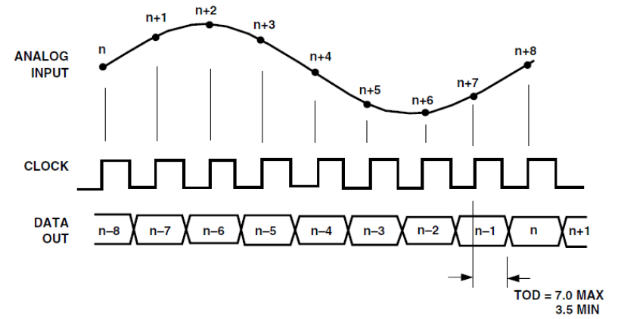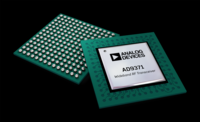High-speed ADC9226 Acquisition Experiment (FII-BD9226) – parallel ADC collectors and master the use of ADC9226 – FII-PRA040 Altera Risc-V Experiment 18
Experiment 18 High-speed ADC9226 Acquisition Experiment
18.1 Experiment Objective
Learn about parallel ADC collectors and master the use of ADC9226.
18.2 Experiment Implement
Insert the ADC9226 module face up into the FPGA development board to the GPIO2 and GPIO1 ports which are next to the red-green audio module. Write programs to use this module to test
18.3 Experiment
18.3.1 ADC9226 Module Introduction
ADC9226 module adopts AD9226 chip design of ADI Company. This chip is a monolithic, 12-bit, 65 MSPS analog-to-digital converter (ADC). It uses a single power supply and has an on-chip high-performance sample-and-hold amplifier and voltage reference. It uses a multistage differential pipelined architecture with a data rate of 65 MSPS and guarantees no missing codes over the full operating temperature range.
See Figure 18.1 for ADC9226 timing diagram.

FPGA development board
Figure18.1 ADC9226 timing diagram
From this timing diagram, we know that there is no need to configure the AD9226 chip, as long as the appropriate CLOCK is provided, the chip can perform data acquisition.
18.3.2 Program Design
-
-
-
- AD acquisition sub-module
-
-
As can be seen from Figure 18.1, the high bit of AD9226 is bit[0] and the low bit is bit [11], so the data bit order needs to be reversed in the program.
| module ad_9226(
input ad_clk, input [11:0] ad1_in, output reg [11:0] ad_ch ); always @(posedge ad_clk) begin ad_ch[11] <= ad1_in[0] ; ad_ch[10] <= ad1_in[1] ; ad_ch[9 ] <= ad1_in[2] ; ad_ch[8 ] <= ad1_in[3] ; ad_ch[7 ] <= ad1_in[4] ; ad_ch[6 ] <= ad1_in[5] ; ad_ch[5 ] <= ad1_in[6] ; ad_ch[4 ] <= ad1_in[7] ; ad_ch[3 ] <= ad1_in[8] ; ad_ch[2 ] <= ad1_in[9] ; ad_ch[1 ] <= ad1_in[10] ; ad_ch[0 ] <= ad1_in[11] ; end endmodule |
-
-
-
- Data conversion program
-
-
The AD9226 module design uses an internal reference source. VREF is the output port of the reference source, which can be used for 1V and 2V reference voltages. It can be selected through SENCE. When SENCE is grounded, a 2V reference is provided, and when SENCE is connected to VREF, a 1V reference is provided. The module uses a 2V reference power supply. VINA input range is 1.0 ~ 3.0V.
The 22 (12) pin of AD9226 has the function of collecting data selection. There are two input and output data formats of AD9226. For the specific format, refer to the 9226 datasheet. The 22 (12) pin of the AD9226 module in this experiment is connected to high level, so it uses Binary Output Mode. The BCD conversion submodule has been introduced in Experiment 8 and is not repeated here.
-
-
-
- 9226 module AD acquisition range selection
-
-
The attenuation range of the AD acquisition module is divided into gears. Press the UP key on the development board to switch the range.
Table 18.1 Gear shift indication table
Gear comparison table (input voltage percentage) |
Corresponding indicator |
| 4% | led0 lit |
| 8% | led0, led1 lit |
| 20% | led0, led1, led2 lit |
| 40% | led0, led1, led2, led2 lit |
| module range (
input wire clk , input wire rst_n , input wire key , output wire [3:0] led , output wire [1:0] scope ); wire flag_switch ; key_process key_process_inst( .clk (clk) , .rst_n (rst_n) , .key_switch (key) , .flag_switch (flag_switch) ); reg [1:0] scope_st =00 ; reg [3:0] led_temp =4’he ; always @ (posedge clk ,negedge rst_n) begin if (~rst_n) begin scope_st <= 0 ; led_temp <= 4’he ; end else begin case (scope_st) 0: begin led_temp <= 4’he ; if (flag_switch ) scope_st <= 1 ; end 1: begin led_temp <= 4’hc ; if (flag_switch ) scope_st <= 2 ; end 2: begin led_temp <= 4’h8 ; if (flag_switch ) scope_st <= 3 ; end 3: begin led_temp <= 4’h0 ; if (flag_switch ) scope_st <= 0 ; end endcase end end assign led = led_temp ; assign scope = scope_st ; endmodule |
-
-
-
- Main program design
-
-
The main program is divided into three sub-programs, which are AD_9226 acquisition module, data conversion calculation module volt_cal, and voltage value segment display module. The segment display part has been introduced in the previous experiment and will not be introduced here.
| module high_speed_ad_test(
input wire sys_clk, input wire otr , input wire key_switch , input wire sys_rst_n , input wire [11:0] ad1_in, output wire ad1_clk, output wire [5:0] sel, output wire [3:0] led , output wire cain_a, output wire cain_b, output wire [7:0] sm_db ); assign ad1_clk = sys_clk ; assign sm_db={point1, ~sm_db_r }; wire [19:0] ch1_dec; wire [11:0] ad_ch1 ; wire ch1_sig ; wire point1 ; wire [6:0] sm_db_r ; ad_9226 u1 ( .ad_clk (sys_clk), .ad1_in (ad1_in ), .ad_ch (ad_ch1 ) ); volt_cal u2( .ad_clk (sys_clk), .ad_ch1 (ad_ch1), .ch1_dec (ch1_dec), .ch1_sig (ch1_sig) ); led_seg7 u3( .clk (sys_clk), .rst_n (sys_rst_n ), .otr (otr) , .ch1_sig (ch1_sig ), .ch1_dec (ch1_dec), .sel (sel), .point1 (point1), .sm_db (sm_db_r) ); range u4( .clk (sys_clk), .rst_n (sys_rst_n ), .key (key_switch) , .led (led), .scope ({cain_b,cain_a}) ); endmodule |
18.4 Experiment Verification
- Pin assignment
| Signal Name | Port Description | Network Name | FPGA Pin |
| sys_clk | System clock | C10_50MCLK | G21 |
| sys_rst_n | System reset | KEY1 | Y4 |
| lg_en | ADG612 input | IO25 | AB20 |
| hg_en | ADG612 input | IO24 | AA20 |
| ad1_clk | Ad acquisition clock | IO28 | R16 |
| otr | Input voltage overrange flag | IO1 | AA13 |
| sm_db[0] | Segment selection | SEG_PA | B15 |
| sm_db[1] | Segment selection | SEG_PB | E14 |
| sm_db[2] | Segment selection | SEG_PC | D15 |
| sm_db[3] | Segment selection | SEG_PD | C15 |
| sm_db[4] | Segment selection | SEG_PE | F13 |
| sm_db[5] | Segment selection | SEG_PF | E11 |
| sm_db[6] | Segment selection | SEG_PG | B16 |
| sm_db[7] | Segment selection | SEG_DP | A16 |
| sel[0] | Bit selection | SEG_3V3_D0 | E12 |
| sel[1] | Bit selection | SEG_3V3_D1 | F11 |
| sel[2] | Bit selection | SEG_3V3_D2 | E13 |
| sel[3] | Bit selection | SEG_3V3_D3 | E15 |
| sel[4] | Bit selection | SEG_3V3_D4 | D19 |
| sel[5] | Bit selection | SEG_3V3_D5 | F14 |
| ad1_in[0] | AD9226 acquisition data bus | IO0 | V12 |
| ad1_in[1] | AD9226 acquisition data bus | IO5 | Y13 |
| ad1_in[2] | AD9226 acquisition data bus | IO4 | AB13 |
| ad1_in[3] | AD9226 acquisition data bus | IO3 | AB14 |
| ad1_in[4] | AD9226 acquisition data bus | IO6 | W13 |
| ad1_in[5] | AD9226 acquisition data bus | IO2 | R14 |
| ad1_in[6] | AD9226 acquisition data bus | IO7 | AA14 |
| ad1_in[7] | AD9226 acquisition data bus | IO29 | U16 |
| ad1_in[8] | AD9226 acquisition data bus | IO30 | AA15 |
| ad1_in[9] | AD9226 acquisition data bus | IO31 | T16 |
| ad1_in[10] | AD9226 acquisition data bus | IO27 | V16 |
| ad1_in[11] | AD9226 acquisition data bus | IO26 | U17 |
| led0 | Input signal attenuation indicator | LED0 | J5 |
| led1 | Input signal attenuation indicator | LED1 | J6 |
| led2 | Input signal attenuation indicator | LED2 | H5 |
| led3 | Input signal attenuation indicator | LED3 | H6 |
| key_switch | Attenuation switch | PB2 | V5 |
- Board verification
Use this experimental development board to connect the DA9667 module to generate a 1M sine wave as a signal source. Use the AD9226 module to connect to GPIO1 and GPIO2 of the PRA040 development board and apply a logic analyzer to capture the signal as shown in Figure 18.2. The following waveform can be observed. From the left to the right of the segment display, the first segment display is selected and lit to indicate that the input measurement voltage exceeds the AD9226 measurement range (the absolute value of VINA-VINB is less than or equal to the reference voltage, and the reference voltage of this module is 2V). The second segment display shows the sign of the input voltage (VINA-VINB). The last four digits are the input voltage value. When the input signal value is a slowly changing signal, the segment display can display the signal voltage amplitude.

Figure 18.2 Measured signal waveform of AD9226 captured by logic analyzer


